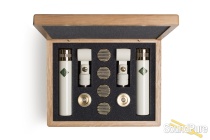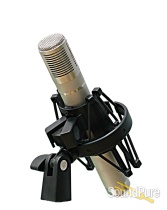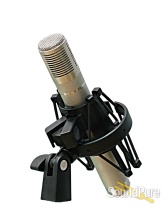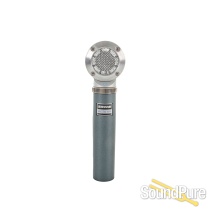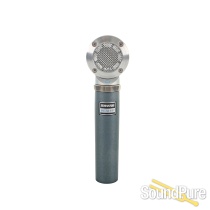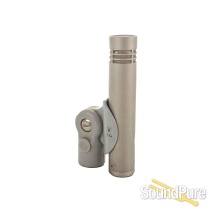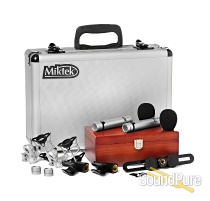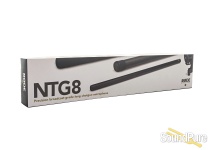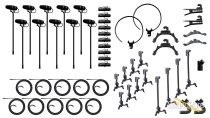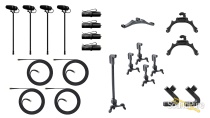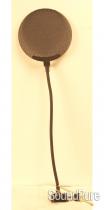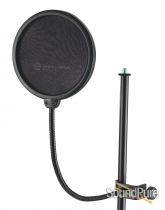-
Call Us Toll Free888-528-9703
-
Local/International (+1)919-682-5552
- Call Us! Toll Free! 888-528-9703
- Local / International (+1) 919-682-5552

"Gone, Baby, Gone"
This one is sold. Don't miss the next one. Some things never even make it to the site so stay up to date on our used collection.
We get in many oddities, rare and vintage products, most of which go fast. If you're on the hunt for something specific, something unique, or something priced right, let us notify you on our used collection before the items even hit the site.
Want to know if one lands?
Notify MeWant to discuss what's coming?
Manufacturer's Description from Gefell
M294 / M295 large diaphragm 1" cardioid condenser:
The Gefell M294, like the M295, is a precision cardioid condenser pencil microphone with an extended bandwidth for the utmost in natural sound reproduction. Derived from Gefell's test, measurement and instrumentation division, the M295 employs a pure 0.8 micron nickel diaphragm in a ceramic housing for temperature-stable performance. The extremely low membrane distortion of the pure nickel diaphragm even when subjected to extreme sound pressure levels assures a colour-free reproduction of the source.
Design Features
Following the nomenclature used in the world of test, measurement and instrumentation, the M295 is referred to as 1" microphone. This designates the outside physical diameter of the capsule head. In fact, the Gefell M295 employs a large hand-stretched 19mm pure nickel diaphragm. The M295's ultra-thin 0.8micron membrane provides exceptional precision and articulation. A ceramic capsule housing provides incomparable stability thus ensuring the microphone's performance remains stable as temperatures change and ballistic pressures vary. Ceramics have the distinct advantage over metals whereby they do not expand or contract when submitted to temperature drift. Furthermore, a proprietary Teflon treated back-plate electrode provides a protective layer that ensures the membrane will not "bottom out" when subjected to extreme sound pressure levels. This allows the M295 to be used in many applications that were previously impractical or simply impossible.
The capsule housing is mounted on a unique shock-mounted pedestal that both serves in defining the highly controlled cardioid pattern while also refracting troublesome body reflections away from the capsule. Careful control of air molecule vibrations is critical to achieving pristine reproduction. As such, by reducing modal interaction, phase cancellation is minimized. This of course is most noticeable at higher frequencies where precise harmonic detail is desired.
There are two on-mic controls, located mid-way down the body stem in a recessed control zone. A 10dB pre-attenuation switch allows the M295 to be used in extreme sound pressure fields where levels may reach 143dB. Also, a low frequency roll-off (-15dB@60Hz) is provided to allow the M295 to be used for close micing when proximity build may need to be reduced at the source.
The capsule amplifier is a proprietary low-noise design that features a balanced symmetrical output. The linear performance extends from 5Hz to 100kHz and is capable of extreme sound pressures without flinching.
--------------------------------------------------------------------------------Using the mics
The M295 features a simple yet elegant body design. This of course has the distinct advantage of reduced "vortex" around the mic while also making placement easy in tight spaces. The M295 is connected using a 3-pin XLR cable following the AES standard and need only 48V phantom powering from a mic pre-amp of console.
For applications where vibration-borne noise may be encountered, using the optional EA21 elastic suspension is recommended. This basket style suspension features a unique "clamp" that secures the microphone for unrestricted positioning.
The direction for maximum sensitivity is axial while these microphones enjoy smooth rendering of the upper response as one transitions off-axis to the sides. This is of particular benefit when recording in the diffuse field where capturing the ambiance is a vital part of the desired outcome.
For close micing such as speech or solo voice, the use of either the optional W20 windscreen or a pop-filter is recommended. For a natural representation, engaging the low-frequency roll-off will reduce the proximity build and over-emphasis of the bass spectrum.
Gefell M294 mid and far field cardioid
The M294 is corrected for mid to far field recording, and is characterized with an emphasized presence peak in the 8kHz region. This particular voicing allows the engineer to aim the microphone at the source capturing greater detail, clarity and depth while capturing the diffuse sound field.
Gefell M295 near-field cardioid The M925 is corrected for near and mid field recording, and is characterized with a virtually linear upper stratum with only a very slight presence-rise, while the low-frequency content is naturally attenuated to compensate for proximity-build. This makes the M295 particularly well suited for close micing of solo instruments where the most natural rendering is desired.
Gefell M296 omnidirectional
The M296 features a linear response that extends to 20kHz with a slight presence rise to correct for use in the diffuse field. The natural and exceptionally detailed response of the M296 makes it ideal for all types of recording where capturing the natural sound or the instrument and the natural ambience is desired.
Gefell M296S test, measurement and instrumentationThe M296S transitions from the "musical" characteristics that are voiced in the previous models to becoming a true measurement microphone. The Gefell 296S employs a 0.4micron ultra-thin, pure nickel diaphragm to assure absolute flat response both on and off axis, adhering to the DIN-EN 60.651 Class-2 criteria for sound level meters.
-------------------------------------------------------------------------------- Interpretation
The Gefell M294, M295 and M296 condenser microphones offer the superior characteristics of a pure large nickel diaphragm resulting in a natural yet brilliant tone. The low intrinsic noise and remarkable output distinguishes these microphones as the optimum choice for critical recording for orchestra, ensemble or solo instrument and voice.
These come standard in an attractive satin nickel finish and may be factory ordered with a distinctive yet visually "invisible" black housing for reduced visibility on stage. All microphones are hand made and individually tested in an anechoic chamber. Hand-selected, stereo-matched sets are may be factory ordered.

About Manufacturer
Since its founding by Georg Neumann in 1928, the company has produced high quality, condenser microphones for broadcasting and recording. Many models have used the M7 capsule originally designed by Mr. Neumann in 1949 for the CMV563a. The M7 was responsible for the legendary sound of the Berlin manufactured U47, U48 and M49 microphones. Today, under the technical supervision of Mr. Kuehnast's son, the Company still produces the M7 capsule in exactly the same way Mr. Neumann taught the elder Kuehnast in the 1940's. Hand drilling each hole in the backplate, making the PVC membrane, and even gluing it together by hand is done just as Mr. Neumann specified. The M7 is currently used in the UM 92.1S, UMT800, UMT70S and MT71S Gefell manufactured microphones.
Some of the production equipment which Microtech Gefell GmbH uses for capsule production capitalizes on advanced technology developed by the Soviets before Perestroika. One of the more recently developed microphones, the M300, uses a capsule made of ceramic material molded under high pressure and plated with chromium. This technology was developed in Moscow using advanced computer modeling and simulation techniques. Gefell perfected a capsule manufacturing process unlike any employed in making Western microphones.
The SMS70 series of microphones designed in the early 1970's used a hybrid amplifier with an fet stage. Hybrid technology was not adopted by manufacturers of Western microphones until the late 1980's. Microtech's newest amplifier for the UMT70S series microphones uses surface mount device (SMD) technology.
The company also manufactures a complete line of measurement microphones equivalent to those of Bruel & Kjaer, the Danish manufacturer. These microphones are tested to the highest standards currently used in the West. The manufacturing methods for the nickel membranes and backplate assemblies are highly advanced. Testing each microphone takes a minimum of three months to guarantee performance and stability when it leaves the factory.
Before the Reunification of Germany the company manufactured their studio and broadcast microphones for RFT, a state agency that distributed them to customers in the Eastern Bloc. Most of the microphones went into the broadcast system. Some microphones, like the PM 860, went into public address systems. Virtually every town hall and auditorium in the former Soviet Union has one. About 1985, the Company began developing high powered (30 to 100 Watt) industrial lasers. They still use a laser engraving machine to put the name and serial numbers onto microphones and other finished metal products. During this period, the East German government poured 60 Million Ost Mark into the company allowing them to buy sophisticated equipment and construct a new building.
Specifications
Pattern: Cardioid
Response: 40Hz ~ 18kHz
Sensitivity: 17mV/Pa
Self noise: 13dB
Signal to noise: 81dB
Maximum SPL: 143dB
Dynamic Range: 120dB
Power requirement: 48V Phantom




